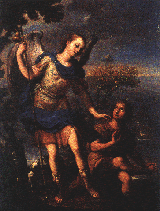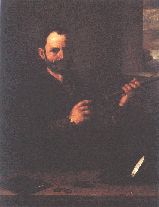 RT
RT  ALLERIES
ALLERIES  |
Despite the museum's emphasis on Mexico's
applied arts, the collection endowed by Franz Mayer to
the people of Mexico also includes a section of European
and Mexican paintings.
The collection of European paintings -by far the most numerous- has been chronologically arranged according to their place of origin. The Spanish collection features works from the 16th to the 20th centuries, including important paintings by Jose de Ribera "El Españoleto", Francisco de Zurbaran, and Ignacio Zuloaga among others. The Italian section features Lorenzo Lotto's The Antiquarian, and The Portrait of Leonor of Toledo painted by Alessandro Allori, il Bronzino. |
Another selection is made up of Netherlandish painting and German works. The former refers to art from the north of Belgium and the south of Holland, painted during the 15th and 16th centuries. Among these is a landscape by the imitator of Jacob Grimmer and a St. Christopher from the 16th century, painted on wood by an artist known as the Master of the Embroidered Leaves.
Painting from the Netherlands is remarkable for its attention to detail in the use of exquisite backgrounds and landscapes as decorative elements in religious scenes.
The German collection includes works which are extraordinary for their gothic elements, solemnly portrayed in religious themes, as in a Nativity by Bartolomeus van Bruyn, the elder, painted in the 16th century.
Flemish and Dutch works cap the European collection with handsome and valuable examples of hunting scenes, banquets, and scenes depicting daily life. They include portraits as well as religious scenes with an evident delight in the representation of nature. A canvas displaying a remarkable delicacy is attributed to the late 17th century Dutch painter Frans van Mieris.
 |
Mexican painting is represented by several colonial pieces, including several brilliantly executed religious paintings by such prominent artists as Juan Correa, Miguel Cabrera, Juan and Nicolas Rodriguez Juarez and others. From the 16th to the 18th century, Mexican painting was almost entirely religious and played an important didactic role. The immense artistic production of the colonial period was due to the dominant role that religion played in the daily life of our ancestors. The reconstruction of an 18th century sacristy exhibits a variety of elements -including paintings- which decorated these enclosures. |
The collection also includes extraordinary examples of secular art such as portraits of ell-known figures from the 18th century, elegantly dressed in the fashion of the time. Finally, the 19th and 20th centuries are represented in a landscape by Jose Maria Velasco, and an early painting by Diego Rivera entitled El Paseo de los melancolicos.




©Todos los derechos reservados, se prohibe la
reproducción salvo permiso por escrito del autor.
©All rigths reserved, material duplication is prohibited
without written authorization by its author.